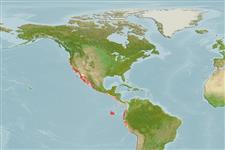>
Scombriformes (Mackerels) >
Trichiuridae (Cutlassfishes) > Lepidopodinae
Etymology: Lepidopus: Greek, lepis = scale + Greek, pous = foot (Ref. 45335); fitchi: Named in honor of the late John Fitch, indefatigable student of California fishes (Ref. 12696).
Eponymy: John Edgar Fitch (1918–1982) was a marine biologist and ichthyologist who was Director of the US Fisheries Laboratory, San Diego. He wrote: Offshore fishes of California (1958). (Ref. 128868), visit book page.
More on authors: Rosenblatt & Wilson.
Environment: milieu / climate zone / depth range / distribution range
البيئة
بحري قاعية التغذية و المعيشة; نطاق العمق 100 - 500 m (Ref. 6181), usually 100 - 250 m (Ref. 9351). Deep-water; 46°N - 17°S, 128°W - 75°W (Ref. 6181)
Eastern Pacific: Cape Kiwanda, Oregon, USA to the Gulf of California; then from 5°N to southern Peru.
الحجم / وزن / العمر
Maturity: Lm ? range ? - ? cm
Max length : 210 cm SL ذكر/ مختلط الجنس; (Ref. 9351); common length : 150 cm SL ذكر/ مختلط الجنس; (Ref. 9351); أعلا وزن تم نشرة: 1.4 kg (Ref. 6181)
الأشعة الظهرية الناعمة (المجموع) : 78 - 87; شوكة شرجية: 2; أشعه شرجية لينه: 41 - 50; فقرات: 84 - 93. Upper head profile slightly convex, rising gently from snout to dorsal-fin origin. Orbits nearly touching dorsal profile; interorbital space slightly concave. Pelvic fins reduced to 1 scale-like spine and 1 - 2 tiny rays. Pyloric caeca 16 - 18. Color of body is black or brown with a silvery shine along the abdomen.
Benthopelagic on the continental shelf and slope, up to a depth of 400 m or more; generally found over sandy bottoms at a depth between 100 and 250 m (Ref. 9351). During cold season, it is often seen near the surface at nights when the moon is full (Ref. 9351). May also be encountered in surge zones and sometimes observed to be beached in large numbers by the shore (Ref. 9351). A schooling species which feeds on cephalopods, euphausiids and small fishes, including Engraulis mordax and juvenile Merluccius productus. Marketed fresh and frozen (Ref. 9351). Excellent food fish, also processed into fish meal and oil (Ref. 9351).
Life cycle and mating behavior
النضج | التكاثر | وضع البيض | بيض | الخصوبة | Larvae
Nakamura, I. and N.V. Parin, 1993. FAO Species Catalogue. Vol. 15. Snake mackerels and cutlassfishes of the world (families Gempylidae and Trichiuridae). An annotated and illustrated catalogue of the snake mackerels, snoeks, escolars, gemfishes, sackfishes, domine, oilfish, cutlassfishes,. scabbardfishes, hairtails, and frostfishes known to date. FAO Fish. Synop. 125(15):136 p. (Ref. 6181)
IUCN Red List Status (Ref. 130435: Version 2024-2)
استخدامات بشرية
مصائد: غير مهمة تجارياً
أدوات
تقارير خاصة
Download XML
مصادر علي الأنترنت
Estimates based on models
Preferred temperature (Ref.
123201): 8.2 - 15.4, mean 12.8 °C (based on 70 cells).
Phylogenetic diversity index (Ref.
82804): PD
50 = 0.5156 [Uniqueness, from 0.5 = low to 2.0 = high].
Bayesian length-weight: a=0.00275 (0.00104 - 0.00730), b=3.06 (2.83 - 3.29), in cm total length, based on LWR estimates for this (Sub)family-body shape (Ref.
93245).
مستوى غذائي (Ref.
69278): 4.1 ±0.59 se; based on food items.
المرونه (Ref.
120179): منخفض, الحد الزمني الأدني لتضاعف عدد أفراد المجتمع 4.5-14 سنة (Preliminary K or Fecundity.).
Fishing Vulnerability (Ref.
59153): Very high vulnerability (90 of 100).
Nutrients (Ref.
124155): Calcium = 11.5 [5.3, 23.6] mg/100g; Iron = 0.289 [0.135, 0.650] mg/100g; Protein = 17.2 [15.5, 18.8] %; Omega3 = 0.209 [0.095, 0.481] g/100g; Selenium = 30.3 [11.9, 77.8] μg/100g; VitaminA = 8.03 [1.37, 41.90] μg/100g; Zinc = 0.26 [0.17, 0.43] mg/100g (wet weight);
